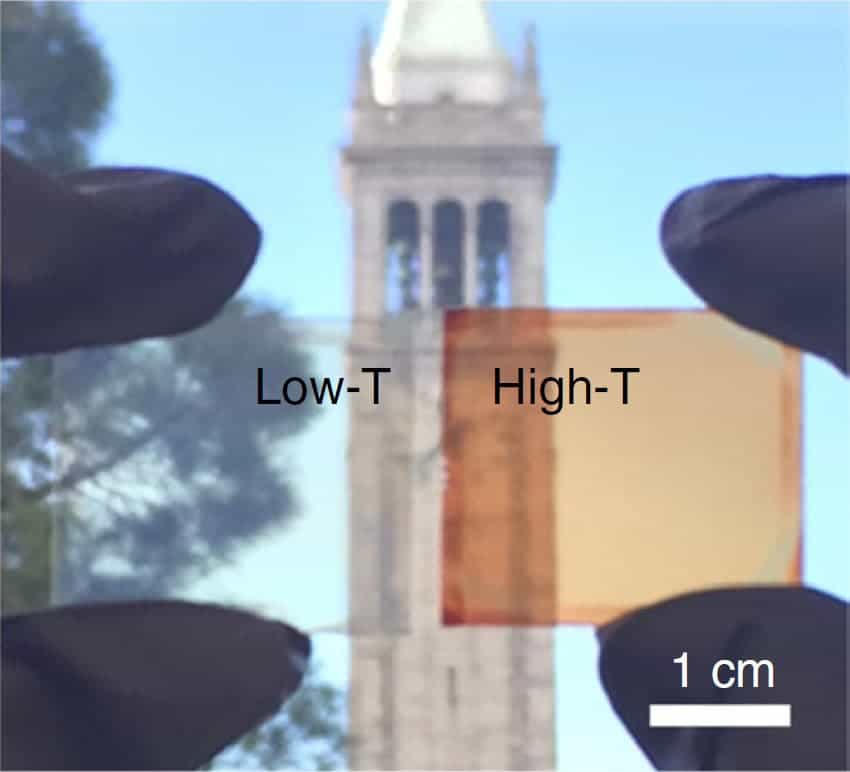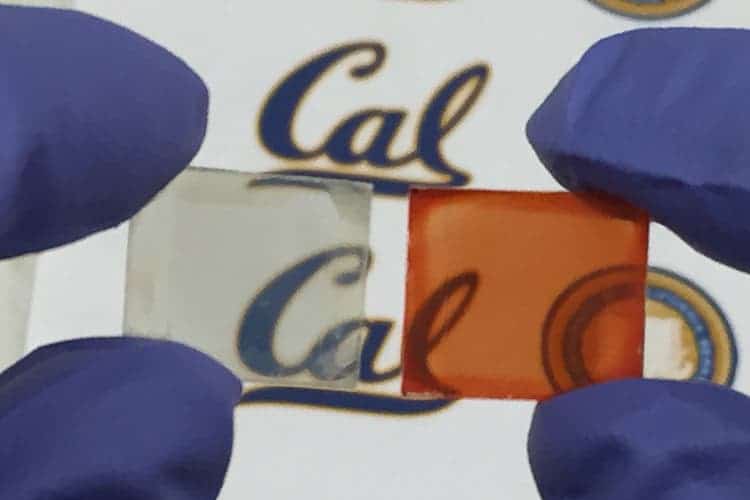Berkeley chemists devised a new type of photovoltaic out of cesium-doped perovskite that not only provides power but also doubles as a tinted window. At room temperature, the solar cell is transparent but automatically tints once the temperature rises, blocking the sun, thereby cooling the space behind the window, and generating electricity at the same time.

Peidong Yang and colleagues at Berkeley Lab described their creative solar cell in the journal Nature Materials. Yang thinks the invention could be used for smart windows or displays in the buildings, vehicles, and the handheld devices of the future.
“This class of inorganic halide perovskite has amazing phase transition chemistry,” Yang said. “It can essentially change from one crystal structure to another when we slightly change the temperature or introduce a little water vapor.”
A cheap and versatile photovoltaics material
The perovskite mineral was originally found in the Ural Mountains in 1839, but it was only in 2009 that its ability to transport solar energy and convert it into electricity was discovered. Just a couple of years later, rated efficiency in the lab had soared from 3.8% to 19.3%, a pace of improvement unmatched by any other solar technology. Currently, the leading commercial solar tech employs crystalline silicon solar cells, which convert roughly 25% of incoming photon energy into electricity but have decades worth of research behind them.
What makes this mineral so exciting is its uncanny ability to diffuse photons over a long distance throughout the cell when prepared in a liquid solution. Typically, solar cells convert energy to electricity by exploiting the hole-pair phenomenon. The photon hits the semiconducting material, then if its energy falls into the semiconductor band gap, an electron is knocked off, leaving a gap in the material or a ‘hole’. The electron travels from atom to atom within the material, occupying holes and knocking out other electrons at the same time until it eventually reaches an electrode and has its charge transferred to a circuit. Last step: profit and generate electricity.
The key is to have electrons moving for as long as possible, and thanks to its diffusing capabilities, perovskite can theoretically generate more electricity than silicon. Perovskite is also dirt cheap which is highly important if we’re ever to cover a significant portion of the planet’s surface with solar cells for a 100% sustainable energy future. Organometal halide perovskites can also be used the other way around — namely turning electricity into light with high-brightness LEDs, manufactured at low cost and more easily than current commercially-available options.

Pull the shades
Yang and colleagues showed that perovskite can be extremely versatile. By tweaking the chemicals in the materials (cesium, lead, iodine, and bromine), the researchers were able to change the material’s transparency.
For the last couple of years, the team has been working on a perovskite solar cell that changes from transparent to opaque when heated. Last year’s version could tint when heated but the cell’s conversion efficiency dropped drastically after several cycles. The new cell retains its conversion efficiency after many cycles between transparent and reddish-tint.
One major downside is that the warmed perovskite transforms only up to 7% of its energy into electricity, which is well below conventional solar cells. Another drawback is that the cells won’t tint unless they’re heated to more than 100°C. However, the researchers claim they’ve already come up with a variation that switches between 50°C–60°C. With a bit more tweaking, they might just find the right composition for their perovskite.
“The solar cell shows fully reversible performance and excellent device stability over repeated phase transition cycles without any color fade or performance degradation,” said Minliang Lai, a graduate student in Yang’s group. “With a device like this, a building or car can harvest solar energy through the smart photovoltaic window.”



